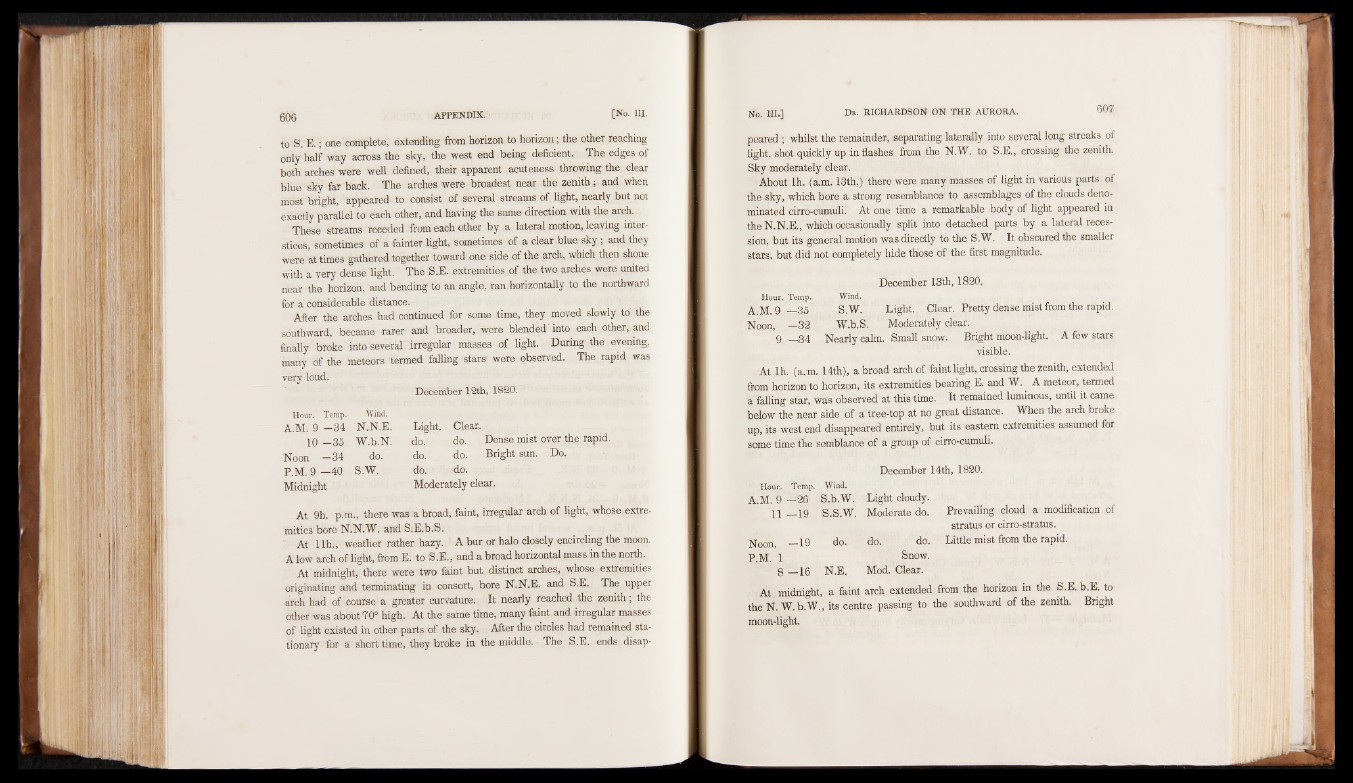
to S. E.; one complete, extending from horizon to horizon; the other reaching
only half way across the sky, the west end being deficient. The edges of
both arches were well defined, their apparent acuteness throwing the clear
blue sky far back. The arches were broadest near the zenith; and when
most bright, appeared to consist of several streams of light, nearly but not
exactly parallel to each other, and having the same direction with the arch.
These streams receded from each other by a lateral motion, leaving interstices,
sometimes of a fainter light, sometimes of a clear blue sky; and they
were at times gathered together toward one side of the arch, which then shone
with a very dense light. The S.E. extremities of the two arches were united
near the horizon, and bending to an angle, ran horizontally to the northward
for a co Aftern sthidee raarbclhee sd ihstaadn cceo.ntinued for some time, they moved slowly to the
southward, became rarer and broader, Were blended'into each other, and
finally broke into several irregular masses of light. During the evening,
many of the meteors termed falling stars were observed. The rapid was
very loud.
December 12th, 1820.
Hour. Temp. Wind. A.M. 9 —34 N.N.E. Light.
10 -3 5 W.b.N. do.
Noon —34 do. do.
P.M. 9 —40 S.W. do.
Midnight
Clear.
do. Dense mist over the rapid.
do. Bright sun. Do.
do.
Moderately clear.
At 9h. p.m., there was a broad, faint, irregular arch of light, whose extremities
bore N.N.W. and S.E.b.S.
7 At llh., weather rather hazy. A bur or halo closely encircling the moon.
A low arch of fight, from E. to S.E., and a broad horizontal mass in the north.
At midnight, there were two faint but distinct arches, whose extremities
originating and terminating in consort, bore N.N.E. and S.E. The upper
arch had of course a greater curvature. It nearly reached the zenith; the
other was about 70° high. At the same time, many faint and irregular masses
of fight existed in other parts of the sky. After the circles had remained stationary
for a short time, they broke in the middle. • The S.E. ends disappeared;
whilst the remainder, separating laterally into several long streaks of
fight, shot quickly up in flashes from the N.W. to S.E., crossing the zenith.
Sky moderately clear.
About lh. (a.m. 13th,) there were many masses of light in various parts of
the sky, which bore a strong resemblance to assemblages of the clouds denominated
cirro-cumuli. At one time a remarkable body of light appeared in
the N.N.E., which occasionally split into detached parts by a lateral recession,
but its general motion was directly to the S.W. It obscured the smaller
stars, but did not completely hide those of the first magnitude.
December 13th, 1820.
Hour. Temp. Wind. A.M. 9 —35 S.W. Light. Clear. Pretty dense mist from the rapid.
Noon, —32 W.b.S. Moderately clear.
9 _34 Nearly calm. Small snow. Bright moon-light. A few stars
visible.
At lh. (a.m. 14th), a broad arch of faint fight, crossing the zenith, extended
from horizon to horizon, its extremities bearing E. and W. A meteor, termed
a falling star, was observed at this time. It remained luminous, until it came
below the near side of a tree-top at no great distance. When the arch broke
up, its west end disappeared entirely, but its eastern extremities assumed for
some time the semblance of a group of cirro-cumuli.
December 14th, 1820.
Hour. Temp. Wind.
A:M. 9 -2 6 S.b.W. Light cloudy.
11 -1 9 S.S.W. Moderate do.
Noon, —19 do. do. do.
P.M. 1 Snow.
8 —16 N.E. Mod. Clear.
Prevailing cloud a modification of
stratus or cirro-stratus.
Little mist from the rapid.
At midnight, a faint arch extended from the horizon in the S.E.b.E. to
the N. W.b.W., its centre passing to the southward of the zenith. Bright
moon-light.